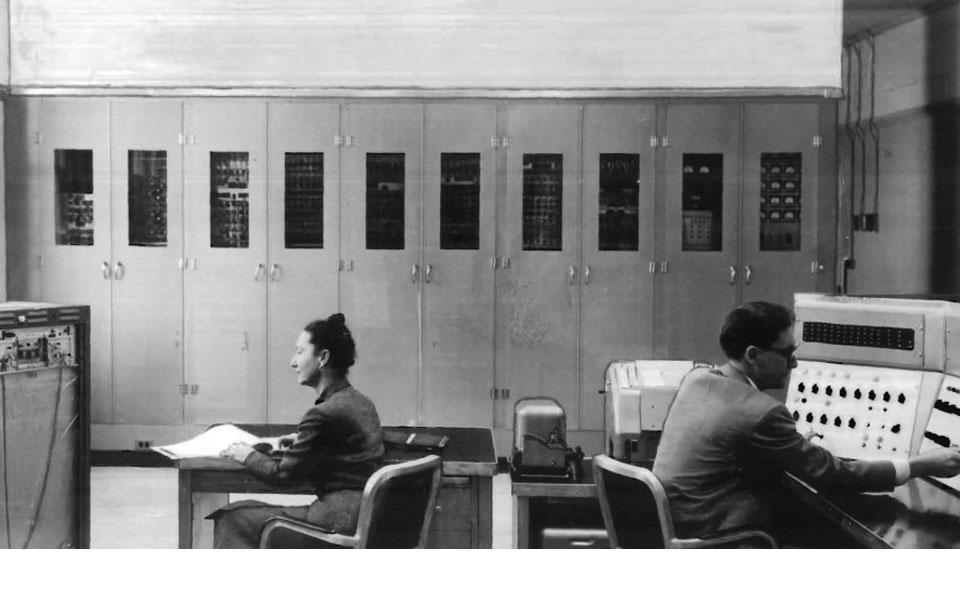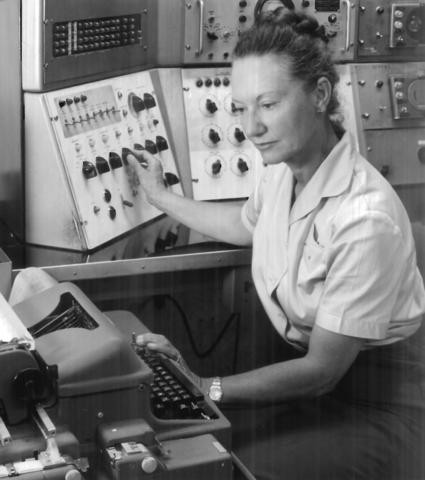Taking Measure
Just a Standard Blog

Ethel C. Marden [left] and Robert D. Elbourn [right] operating SEAC.
Over the course of its 100-plus year history, NIST has had some colorful characters who were also pioneers in their fields. For computer scientist Karen Olsen, one who stands out was Ethel Marden. In the 1950s, Marden wrote programs for the nation’s first internally programmed digital computer: the Standards Eastern Automatic Computer (SEAC). For 13 years, SEAC was a valuable tool used by various government agencies to do everything from accounting to checking calculations for the hydrogen bomb. It led to several innovations, including electric typewriters and the digital scanner, which was used to create the first digital image.

“Marden inspires me because she and I are both computer scientists, but I was also intrigued that she and her husband lived in a McLean, Va., home designed by famous American architect Frank Lloyd Wright that was perched on top of a cliff above a stretch of rapids on the Potomac River,” says Olsen. “She set a world record for scuba diving, crossed the Atlantic with her husband in a sailboat, was an airplane pilot, and lived to be 100 years old.”
Marden is also credited with being the one who successfully lobbied NIST to allow family-friendly part-time and flex-time work schedules. Marden, who worked at NIST from 1948 to 1971 and passed away in 2012, was a vibrant character, as was her husband, Luis, a globe-trotting National Geographic photographer/writer. He pioneered underwater color photography in collaboration with oceanographer Jacques Cousteau and discovered the sunken wreck of the H.M.S. Bounty (the 18th-century British ship portrayed in the movie “Mutiny on the Bounty”).
In a 2001 interview about working on SEAC, former NIST computer programmer Genevie Hawkins Urban paints this picture of her colleague:
“Ethel Marden taught many of us how to program the computer, but she also taught us many of the finer points of life. She instructed us in scuba diving; she herself was an avid scuba diver and held the women’s world record in 1954 for a depth of 165 feet. She showed us how much fun riding in her MG could be, how to open an English muffin so that all the crevices would be there to catch the butter, which wines were good and which to serve with various foods, how to properly serve brandy to get the full aroma—indeed, all the little things that create the good life. The Mardens unveiled their Frank Lloyd Wright house design in 1951, and there were daily reports of the compromises or non-compromises between architect and client. It was 1956 before we had a picnic on the cornerstone.”
In 1983, Marden was interviewed about her involvement with the SEAC. She spoke of the excitement and dedication of the NIST researchers who worked on the groundbreaking project:
“Every day when we went into the office, I think all of us went in with joy in our hearts because we loved our work. We were doing something nobody had done before and we were all excited about our work … Many, many nights, engineers would be there all night. There was no question of payment for any overtime. The group never wanted or asked for overtime pay. [The] motivation is hard to understand unless you have worked in a pioneering environment where you feel you’re developing something new and exciting and can hardly bear to leave it to go home.”
In another oral-history interview after she retired, Marden said, ‘I admire anyone who has done something for the first time … anyone who has been a pioneer in something.”
Olsen applies that inspirational quote to NIST’s mission today: “As did Marden, I feel NIST is on the brink of new technologies,” she says. “We have the capability to be pioneers.”






hello thanks for the information